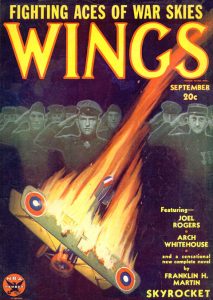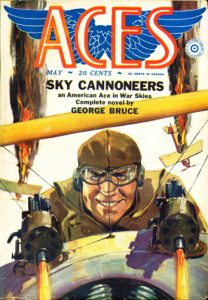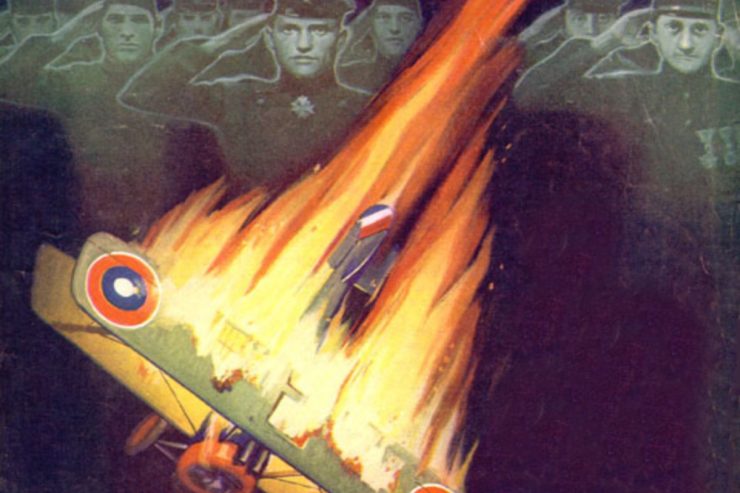 The United States will celebrate Memorial Day on Monday, May 30. According to PBS:
The United States will celebrate Memorial Day on Monday, May 30. According to PBS:
Originally called Decoration Day — from the early tradition of decorating graves with flowers, wreaths, and flags — Memorial Day is a day for remembrance of those who have died in service to our country. It was first widely observed on May 30, 1868, to commemorate the sacrifices of Civil War soldiers . . . In 1873, New York was the first state to designate Memorial Day as a legal holiday. By the late 1800s, many more cities and communities observed Memorial Day, and several states had declared it a legal holiday.
After World War I, it became an occasion for honoring those who died in all of America’s wars and was then more widely established as a national holiday throughout the United States.
This Memorial Day, we’ll begin running our posts detailing our programming plans for the fiftieth PulpFest. These will continue, almost nonstop, through the middle of July.
We hope you’ll join us at PulpFest 50 as we celebrate “A Half-Century of Pulp Cons,” in recognition of our golden anniversary.
PulpFest 50 will also honor the centennial of Fiction House, the pulp magazine and comic book publisher that gave us Action Stories, Fight Comics, Jumbo Comics, Jungle Stories, Lariat Story Magazine, North-West Romances, Planet Stories, Rangers Comics, Sheena, Queen of the Jungle, Wings, and many other classic titles.
Additionally, our fiftieth summertime PulpFest will salute the ninetieth anniversary of Popular Publications’ “Dime” line of pulp magazines, particularly Dime Western and Dime Mystery. Both magazines debuted in 1932 and played a major role in the evolution of popular fiction.
PulpFest 50 will take place from August 4 – 7 at the DoubleTree by Hilton Hotel Pittsburgh – Cranberry in Mars, Pennsylvania. You can become a member of the convention by clicking the Registration button on the PulpFest website. If you need lodging, you’ll also be able to book a room through our site.
Join us at PulpFest 50 for “A Half-Century of Pulp Cons” and “Action for a Dime!”
In the spirit of Memorial Day, it’s our hope that everyone who plans to attend PulpFest 50 will be vaccinated against COVID-19. We have many older members who attend PulpFest. Please keep them in mind. Remember, we’re all in this together. United We Stand!
Pictured above is the September 1934 issue of Wings — with cover art by Rudolph Belarski. It was one of Fiction House’s five aviation pulps. The company also published a short-lived war magazine entitled Soldier Stories. It was converted to Detective Classics in late 1929.
Originally, a general aviation magazine, Wings was the younger sister to Air Stories — the first aviation pulp. In their early years, both magazines mainly ran contemporary aviation stories. Subtitled “The magazine of AIR-ADVENTURE STORIES,” Wings featured tales about daredevil aces, flying circuses, airmail pilots, government agents, aerial photographers, and so on. There were even lost race adventures set in Africa and South America, but with an aviation slant. Most of the air magazines that debuted in the late 1920s mimicked these two Fiction House pulps.
Aviation was booming during the twenties. It was the time of barnstorming, flying circuses, air races, competitions to build inner-city airports and a family plane, and magnificent feats of adventure such as Charles Lindbergh’s solo flight across the Atlantic Ocean. People were “air-minded” and the fiction and letter columns of magazines such as Air Stories and Wings reflected this.
 Two months after the debut of Wings in January 1928 — the Dell Publishing Company launched War Birds, an aviation version of War Stories, the first of the so-called “war pulps.” Fiction House would launch its own air-war pulp magazine later the same year. The first issue of Aces was dated December 1928. It would run for fifty-five issues with its final number dated Spring 1940. Pictured to the right is the May 1929 number, with cover art by H. C. Murphy.
Two months after the debut of Wings in January 1928 — the Dell Publishing Company launched War Birds, an aviation version of War Stories, the first of the so-called “war pulps.” Fiction House would launch its own air-war pulp magazine later the same year. The first issue of Aces was dated December 1928. It would run for fifty-five issues with its final number dated Spring 1940. Pictured to the right is the May 1929 number, with cover art by H. C. Murphy.
Wings became an air-war title during the summer of 1931. Its pilots would fight in both World Wars as well as the Korean War and in a variety of settings during the early days of the Cold War. Wings would run for 133 issues. Its final number was dated Summer 1953.
The remaining Fiction House aviation titles were George Bruce’s Aces (reprinting stories from Aces) and George Bruce’s Air Novels (reprinting stories from Air Stories). Both magazines appeared in 1931. Each lasted but a single issue.
Leslie Silberberg is a writer and popular culture enthusiast who has volunteered to help the PulpFest organizing committee. She is looking forward to writing more for our website and The Pulpster.







